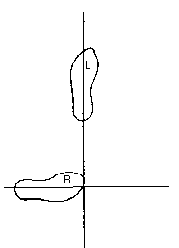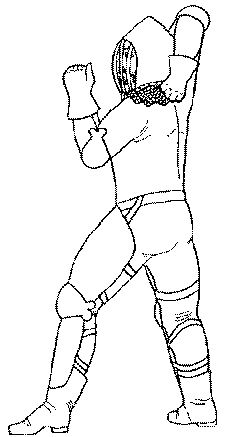|
|
|
Get up and practice what I will describe. Stop and rest whenever you need to. No one will mind if it takes awhile to get it right. Take your time.
But I urge you, I implore you, to get it right. It is far easier to suffer the pains of getting it right the first time than it is to spend years unlearning bad habits.
Of course, most styles start with someone doing it wrong. I started out doing everything "wrong." But I believe for every time someone invents a new style that works, twenty talented opponents give up and go off to stamp collecting or some other more strenuous pursuit, and I have twenty fewer people to play with. I was extremely lucky.
At all times, the fighter wants to be in control of his balance. Your center of gravity must be centered and low, basically just above your reproductive organs. If your balance is too far forward, your blows and defense will be weak. If your balance is too far back, the effect on your arms will be less but your footwork will suffer. So it is vital that you stand straight without leaning front, back, left, or right. STRAIGHT! This includes your neck and head. Don't let your head bob up and down and sideways like some doll in the rear window of a '67 Chevy.
Now twist your hips gently. Make sure that you are not pivoting on one hip, not waving one hip, but twisting both hips with your spine as the center of a circle. If you can twist your hips, you can successfully fight with sword and shield.
For balance, bend your knees. No, lower. No lower still. Your lower shieldside leg should be straight and vertical. Essentially the lower you can bend your knees and stay upright the better. If your upper and lower leg describe a right angle, great!
Most of us find it hard to stand still with bent knees . . . and harder still to move and keep the knees bent. This form of leg strength is something the beginning fighter often lacks. This form of leg strength is something advanced fighters often lack. It does come with practice, though.
All right, legs apart and knees are bent. Now rotate your shieldside foot. Rotate your shieldside foot 90 degrees (1/4 of a circle) away from your swordside. Your toe should be pointing directly at your opponent's eyes. Even an imaginary opponent. I cannot stress how many flaws can be overcome if your knees are bent and your toes pointed correctly. Now imagine a line running from the big toe of your shieldside foot to the heel of the shieldside foot and extending both ways into infinity. Now look down and put your swordside foot entirely behind that line. Your knees are still bent, right? Now the arms.

Your upper arm should be straight up. Let your hand fall. It will normally fall to the top of the spine. Let the sword dangle straight down your back. Your swordside elbow is now sticking in your ear.
For the time being, just wave your shieldside arm in front of you in a vaguely threatening way with your elbow against your ribs.

So the toe of your shieldside foot is pointing at the nose of your foolhardy foe. Your feet are a right angle. Your knees are bent. Your head is upright. You are staring straight at that implacable foe on the other side of your shield. Your swordside arm is straight in the air with your sword (or sword substitute) falling down your back. Your shieldside elbow is against your ribs. You are leaning neither forward nor backward, neither left nor right. You are balanced with your center of gravity low and centered. You are a vision of scarcely controlled power and agility.
Congratulations! You are now ahead of every other beginning fighter. You have a good stance.
I recommend practicing before a full-length mirror. Stand in stance. Look at yourself carefully. Check these major points: Knees bent? Standing straight? Head upright and centered? Elbow up? Swordside foot back? Toe pointed?
I have shouted "Elbow up, sword foot back" about a quadrillion zillion
times at practices. If a fighter can do those two things at all times while
executing the rest of my techniques passably, I will guarantee success.
Continue to Chapter 4